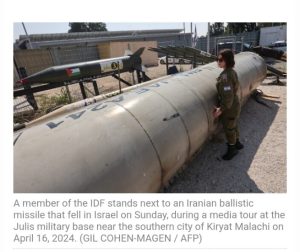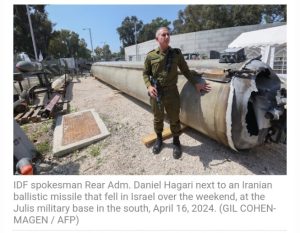IDF Shows Remains Of Iranian Ballistic Missile That Fell In Dead Sea



The Israel Defense Forces on Tuesday showed reporters the remains of a ballistic missile that was intercepted over Israel in the Iranian attack on the country early Sunday.
According to the IDF, the Emad missile had an estimated 500-kilogram (1,100-lb.) warhead.
Only the fuel tank of the missile was recovered, as the warhead and engine were destroyed during its interception by the long-range Arrow air defense system.
The remains of the missile’s fuel tank are just 70 percent of the entire projectile. It was 11 meters (36 feet) long.
The massive missile, one of 120 ballistic missiles fired at Israel, was found on Sunday morning floating in the Dead Sea.
It had flown more than 1,500 kilometers from Iran to Israel in around 12 minutes
He declined to give a timeframe for Israel’s response.
Posting on the social media platform X, IDF spokesman Peter Lerner noted that images of the rocket section floating in the Dead Sea had been shared on the internet soon after the attack.
“When I first saw images on Sunday circulating on social media I thought they were fake,” he wrote. “There is nothing fake about this, or the threat it posed.”
Presenting the remains of the missile to foreign media on Tuesday, IDF Spokesman Rear Adm. Daniel Hagari said: “Iran knew that when she was firing over 110 ballistic missiles besides the cruise missiles, the rockets, the drones — firing 110 ballistic missiles is an escalation to the region… a dangerous escalation.”
“We will respond the way that we will choose at the time that we will choose,” Hagari said, speaking in English. “We don’t just have defensive capabilities — that were proven on Saturday night — We have offensive capabilities. We will know what to do and when to do and how to do.”
Iran launched an unprecedented direct attack at Israel on Saturday night and early Sunday in retaliation for an April 1 strike on a building in its embassy compound in Syria that it blames on Israel, in which several commanders of Iran’s Islamic Revolutionary Guard Corps were killed.
Most of the projectiles were intercepted before they reached Israel, with the help of the US, Jordan, and other allies, and the sole injury was a Bedouin girl, who was struck and seriously wounded by falling shrapnel in the Negev desert. The IAF’s southern Nevatim base suffered minor damage to infrastructure, the IDF said, but continued to function during the attack.
Defense Minister Yoav Gallant said Tuesday Iran had fired 500 ballistic and cruise missiles as well as attack drones in its barrage on the country, clarifying an earlier IDF tally of over 300.
He said just four ballistic missiles made it through defenses, and none of the cruise missiles or drones.
Iran’s missile and drone attack on the country earlier this week “failed” and “they will fail to deter Israel,” Gallant said to troops in northern Israel.
“The Iranians will not be able to implement a different equation of deterrence against the State of Israel,” he said. “The Air Force planes are operating everywhere, the skies of the Middle East are open. Any enemy that will fight against us, we will know how to hit it wherever they are.”
US and European allies have been pressing Israel to refrain from hitting back at Iran militarily while promising to levy tough sanctions on Tehran’s ability to sell oil and build attack drones.
Western powers fear an Israeli retaliation could plunge the region into a wider war that could draw them in while further eroding international support for Jerusalem



